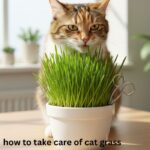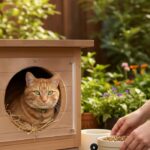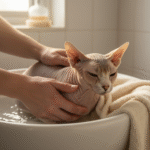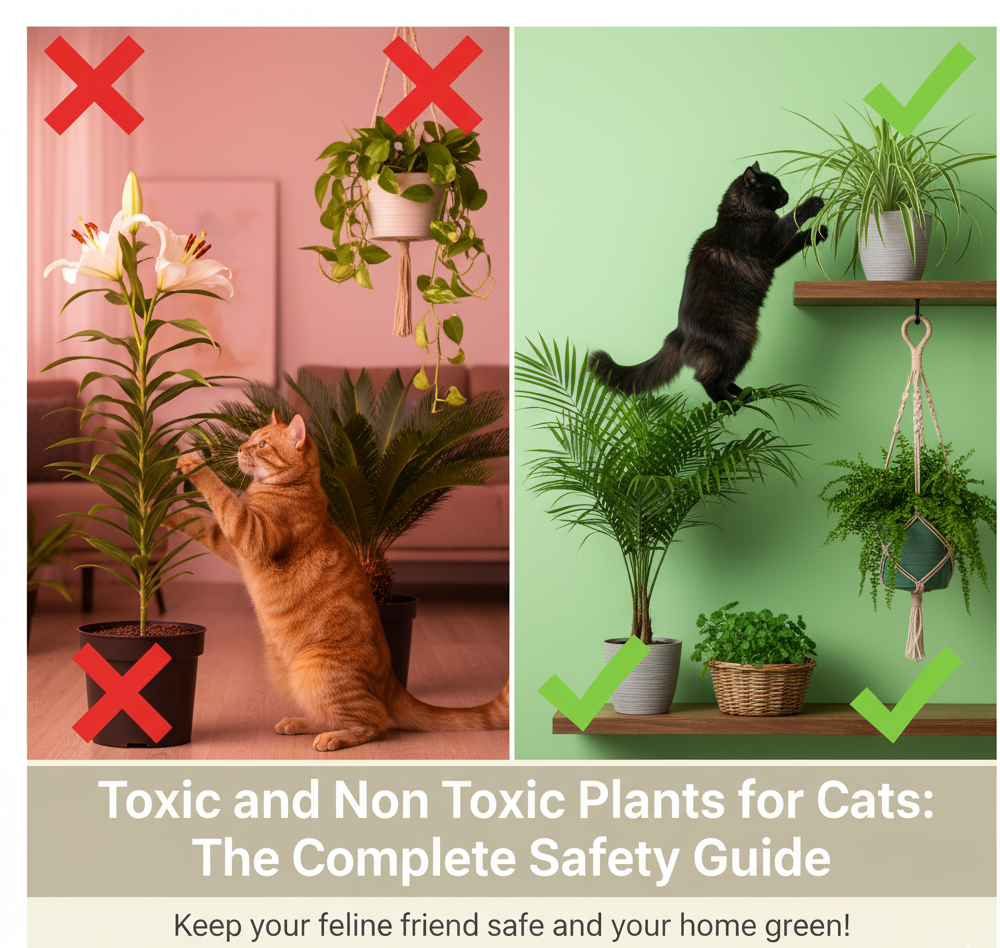Keep your feline friend safe and your home green! Discover a comprehensive guide to toxic and non toxic plants for cats, detailing the dangers of popular houseplants and recommending safe, cat-friendly alternatives.
The Complete Guide to Toxic and Non-Toxic Plants for Cats – Keep Your Feline Safe
As a proud plant parent and cat guardian, you know the struggle: a new, leafy addition to your home is instantly sniffed, batted, and perhaps even sampled by your curious feline. While we love to bring the beauty of nature indoors, it’s crucial to understand that many common houseplants pose a severe risk to our pets. This guide provides a clear, comprehensive breakdown of toxic and non toxic plants for cats, ensuring you can maintain a lush indoor jungle without compromising your kitty’s health.
Why Understanding Toxic and Non Toxic Plants for Cats is Essential
The simple truth is that cats are obligate carnivores, but their curiosity often leads them to explore, chew, and ingest plant matter. This behavior, whether from boredom, a desire for fiber, or simple play, can turn a beautiful houseplant into a veterinary emergency. Plant toxicity varies widely—some cause mild stomach upset, while others, like lilies, can be fatally toxic even in small amounts. Knowing the difference between toxic and non toxic plants for cats is not just a matter of convenience; it’s a vital part of responsible pet ownership.
Non-Toxic Plants for Cats: Safe Selections for Your Home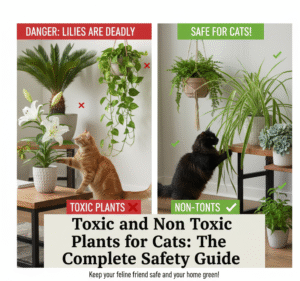
Filling your home with green beauty doesn’t have to be a risk! There are plenty of stunning, easy-to-care-for plants that are perfectly safe for your cat to be around. These non-toxic plants for cats are the ideal choices for a multi-species household.
Creating a Safe Space with Non-Toxic Plants for Cats
Here are some of the best cat-friendly options, confirmed to be safe by organizations like the ASPCA:
- Spider Plant (Chlorophytum comosum): Famous for its air-purifying qualities and easy propagation, the Spider Plant is one of the most popular safe options. Note: While non-toxic, it can sometimes have a mild hallucinogenic effect similar to catnip, which might encourage chewing.
- Areca Palm (Dypsis lutescens): This beautiful, feather-like palm adds a tropical flair and is entirely safe for your pets.
- Calathea (Calathea ornata): Also known as the prayer plant, these stunning plants feature vibrant, patterned leaves that move throughout the day and pose no threat to your feline.
- Bamboo Palm (Chamaedorea seifrizii): A larger, air-purifying option that provides height and texture to your decor without the risk of poisoning.
- Catnip (Nepeta cataria): Of course! This herb is specifically known for its euphoric effect on cats and is perfectly safe for them to ingest.
- Boston Fern (Nephrolepis exaltata): An elegant, cascading fern that is safe. Be aware: many other ferns ARE toxic, so stick specifically to the Boston Fern.
- Blue Echeveria (Echeveria secunda): A beautiful, rosette-shaped succulent that adds modern charm and is non-toxic.
- Ponytail Palm (Beaucarnea recurvata): With its whimsical, bulbous base and curly leaves, the Ponytail Palm is a great, safe choice, and its leaves make a fun, non-threatening toy for bored cats.
❌ Toxic Plants for Cats: The Danger Zone
Now we must address the plants that pose a serious threat. Even if your cat has never chewed a plant before, accidents can happen, so it is always safer to exclude these toxic plants for cats from your home entirely, or place them in an area that is completely inaccessible.
The Most Dangerous Toxic Plants for Cats
Be extremely cautious with the following common household plants:
- Lilies (very dangerous!): Lilium species (Easter, Tiger, Day, Asiatic, etc.) are perhaps the most critical plants to avoid. Ingesting even a small amount—a few petals, a nibble on a leaf, or even drinking the vase water—can cause acute kidney failure in cats, often leading to death if not treated immediately.
- Aloe Vera: Though great for human burns, the saponins in the leaves are toxic to cats, causing vomiting, diarrhea, and lethargy if ingested.
- Dieffenbachia (Dumb Cane): When chewed, the plant releases insoluble calcium oxalates, which cause intense oral irritation, burning, swelling of the mouth, tongue, and throat, and difficulty breathing.
- Pothos (Devil’s Ivy): This popular, easy-to-care-for vine contains calcium oxalates and will cause oral pain, vomiting, and difficulty swallowing.
- Philodendron: Similar to Pothos, this large family of plants contains the same irritating calcium oxalates.
- Sago Palm: Highly toxic, especially the seeds (or “nuts”). Ingestion can cause severe vomiting, bloody stools, liver failure, and death. Every part of the Sago Palm is a major threat.
- Tulips: The bulbs are the most toxic part, but ingestion of any part of the plant can cause gastrointestinal irritation, excessive drooling, and possible cardiac dysfunction.
- Azalea: This popular flowering shrub, even in small amounts, can cause vomiting, diarrhea, drooling, central nervous system depression, and cardiovascular collapse.
Emergency Action: What to Do If Your Cat Ingests a Plant
If you suspect your cat has chewed any of the toxic plants for cats, act immediately. Do not wait for symptoms to appear.
- Stay Calm and Remove the Plant: Take the plant away from your cat and check their mouth for any remaining pieces.
- Identify the Plant: Knowing the exact species of the toxic plants for cats is the most crucial step for the veterinarian.
- Call for Help: Immediately contact your veterinarian or the Pet Poison Helpline (1-855-764-7661) or ASPCA Animal Poison Control Center (1-888-426-4435).
It’s always better to err on the side of caution. Even if the plant is on the list of non-toxic plants for cats, excessive ingestion can still lead to a mild stomach upset.
Proactive Strategies for Coexistence
To ensure harmony between your plant collection and your cat, consider these MECE (Mutually Exclusive, Collectively Exhaustive) proactive strategies:
Physical Barriers
- High Shelves: Place plants on shelves, mantelpieces, or in macrame hangers that are truly out of reach.
- Closed Rooms: Designate a “plant room” (like a sunroom or office) that is off-limits to your cat.
- Terrariums: House smaller plants in a closed, decorative glass enclosure.
Discouragement Methods
- Bitter Sprays: Use a pet-safe bitter apple spray on the leaves of plants to deter chewing.
- Texture Deterrents: Place pinecones, small stones, or crinkled aluminum foil on the surface of the soil to discourage digging and climbing.
- Provide an Alternative: Ensure your cat has its own designated safe-to-chew greens, such as a tray of pet grass or oat grass.
By being informed about both the safe and dangerous options, you can successfully manage the beautiful balance between your green thumb and your furry companion. Choosing toxic and non toxic plants for cats wisely is the single most important step in creating a safe, vibrant home for everyone.
Frequently Asked Questions (FAQs)
If a plant is listed as non-toxic, can my cat eat it freely?
While non-toxic plants for cats (like a Spider Plant or a Boston Fern) will not poison your cat, excessive ingestion of any plant matter can still cause vomiting or diarrhea due to the fibrous nature of the material. Always discourage your cat from chewing on any houseplant, even the safe ones. If they are chewing constantly, it may indicate boredom or a nutritional need.
Is it safe to keep a highly toxic plant for cats if I put it on a high shelf?
It is generally not recommended to keep highly toxic plants, like Lilies or Sago Palms, even on high shelves. Cats are excellent climbers, and a single falling leaf or petal can still be enough to cause serious harm. For the most dangerous toxic plants for cats, exclusion from the home is the only 100% safe option.
What is the most immediate danger when a cat ingests toxic and non toxic plants for cats?
The immediate danger depends on the specific plant. For Lilies, the danger is rapid, acute kidney failure. For plants containing insoluble calcium oxalates (like Dieffenbachia or Pothos), the danger is immediate, intense pain and swelling of the mouth and throat, which can sometimes lead to difficulty breathing. For all instances of confirmed ingestion of toxic plants for cats, the immediate concern is getting veterinary intervention as quickly as possible.




